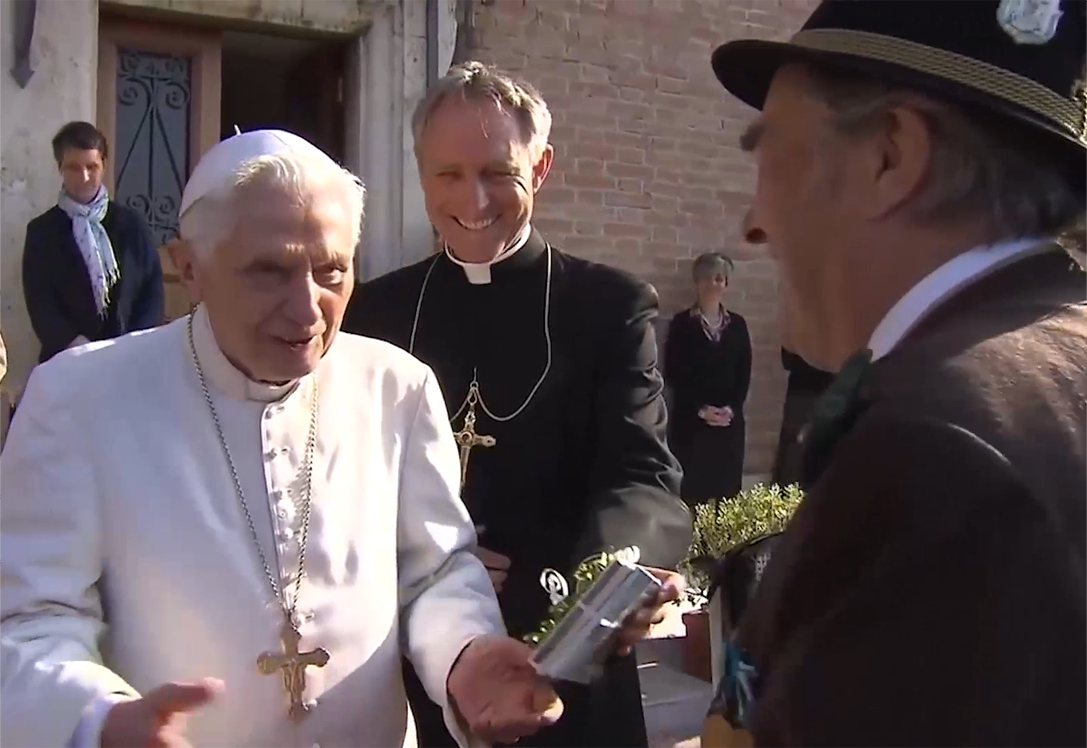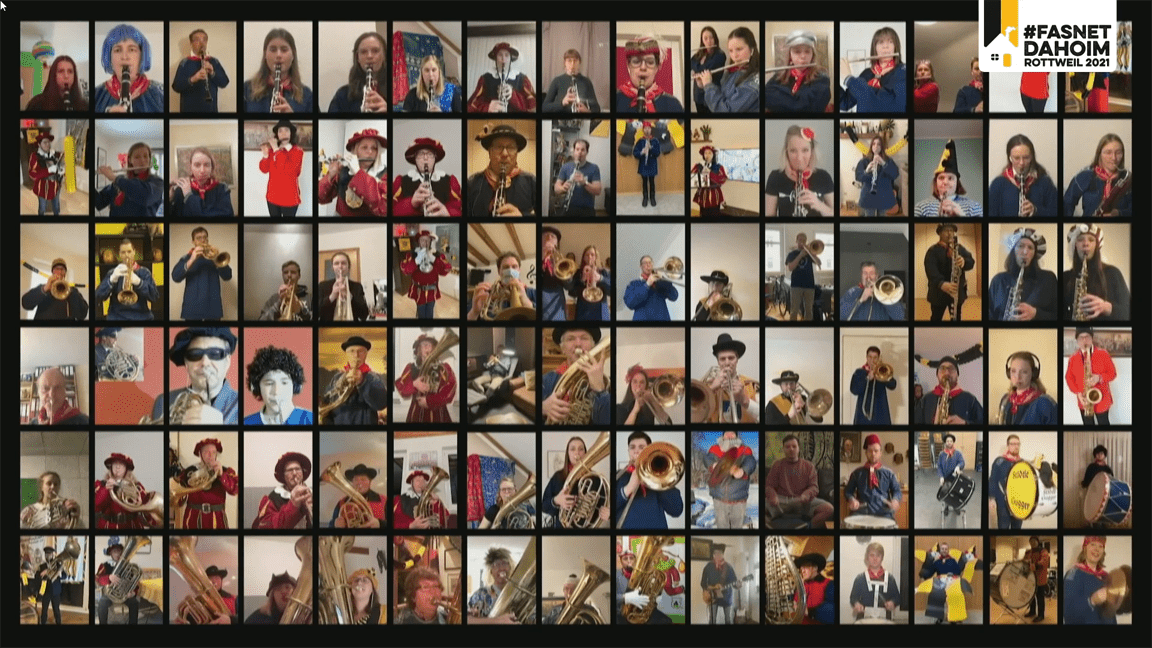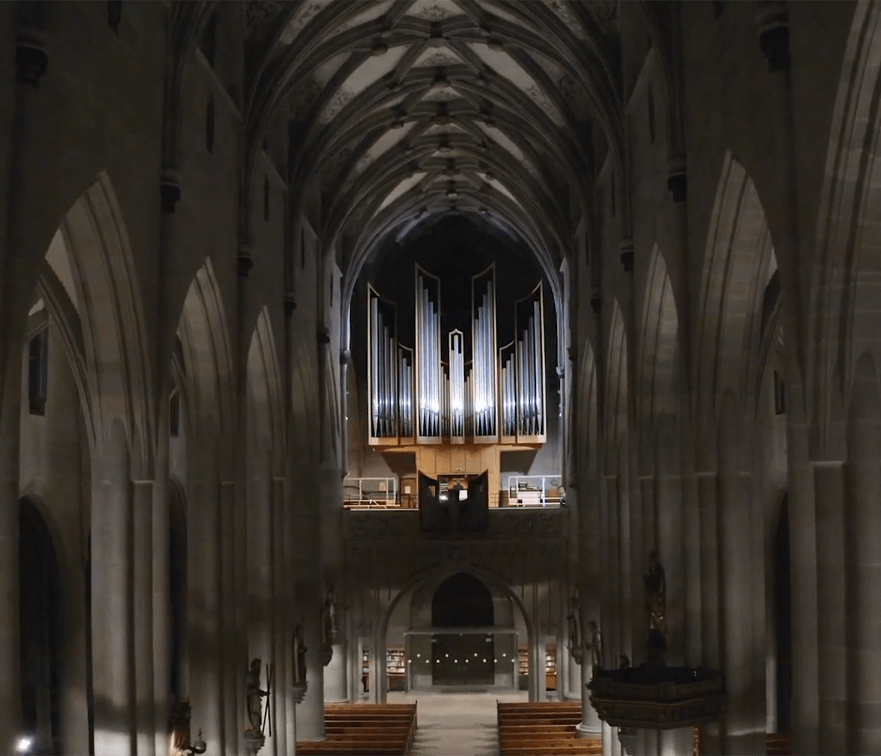Fastnacht is Cancelled
Fastnacht – Cancellations and Creative Crisis Management
The Bajass doll riding across the parquet to the sounds of the fool’s march on a vacuum cleaner robot is not the establishment of a new tradition. But it is one of the countless virtual substitutes that were developed in the wake of Fastnacht’s cancellation in 2021, and which then went viral on the internet. With the global COVID 19 pandemic preventing a lot of social interacting since March 2020, and renewed waves of infection bringing about harsh lockdown measures, it quickly became clear that 2021 would not feature Fastnacht in its usual form. As disappointing as this may have been for hundreds of thousands of people, it was in exactly these circumstances that the vitality of Fastnacht became apparent. The forced abandonment of all in-person events unleashed a creative potential that manifested itself in the virtual realm, and showed the resilience of Fastnacht humour. Take a look at the history of Fastnacht’s cancellation, and then see some of the digital alternatives that arose in 2021 – the year corona kept coming.

Bajass doll on a vacuum cleaner robot, video clip for the cancelled 2021 Fastnacht, author unknown

Years of World Wars and Disasters
Recent history has shown often enough that there is no guarantee of Fastnacht happening. In the 20th century alone, there were 17 years without Fastnacht in Germany due to war. During the First World War, it was dormant from 1915 to 1918. The Überlingen “Narrenchronik” (fool’s chronicle) illustrated this sarcastically with a “Hänsele” garment hanging on a coat hook and covered in cobwebs, juxtaposed with a gas mask as a morbid costume element. In 1919, a few weeks after the guns fell silent, no one felt like celebrating given the suffering and misery. The unstable political situation then meant that there was no Fastnacht for another five years. It was not until 1925 that the tradition was revived. During the Second World War, Fastnacht then experienced its next major break from 1940 to 1945. Out of respect for the millions of dead in a destroyed country, it was also cancelled in 1946. Isolated customary activities, sentimentally charged as an expression of local identity, were permitted again by the Allies in 1947, and from 1948 onwards Fastnacht then gradually returned to its usual forms.

“Narrenbuch” from Überlingen, “Hänsele” replacement 1914 – 1918, entry from 1919, Archiv der Narrenzunft, Überlingen, Stadtarchiv Überlingen

Avoiding Fastnacht in 1991
The 18th Fastnacht and Karneval cancellation of the 20th century occurred in 1991 because of the war in the Persian Gulf. With the fear that an imminent military conflict in the Middle East could see Israel fired upon by Iran’s allies using German-designed missiles, politicians as well as public opinion considered Fastnacht celebrations in Germany that year to be indefensible. When the war against Iraq actually broke out shortly before Fastnacht in 1991, people in both the Swabian-Alemannic region as well as in the Rhineland renounced all organised festivities. The Überlingen fool’s chronicle from 1991 depicts the cancellation with a picture of the Iraqi ruler Saddam Hussein, who has a stranglehold on the weeping Fastnacht world. It is now known that the justification for the US-led attack on Iraq at that time was politically highly dubious. The illustrator of the fool’s chronicle was, of course, only working off of what was known at the time.
“Narrenbuch” from Überlingen, the world of fools in the stranglehold of Saddam Hussein, entry from 1991, Archiv der Narrenzunft Überlingen, Stadtarchiv Überlingen


Fastnacht in the Pandemic
No one could have imagined that Fastnacht would be cancelled in the 21st century because of a pandemic. Something of the sort was no longer considered possible in the modern age. Before 1900, however, there had been repeated Fastnacht cancellations due to epidemics – in the late Middle Ages and in the early modern period, this was mostly due to the plague. And sometimes, epidemics were even directly related to Fastnacht events. Heinrich Heine described the case of the first cholera victim in Paris in 1831. He noted how a participant in a masquerade ball during Karneval festivities there fell over and died. Twenty years later, in 1851, Alfred Rethel gave visual expression to this very scene in his “Dance of Death”: Death enters the ball scene with a bone fiddle and a mask on his wrist, surrounded by masked and costumed victims, while others try to flee in panic. The fact that one of the first hotspots of infection in Germany during the corona epidemic of 2020/21 was also a Karneval ball in Heinsberg in North Rhine-Westphalia reads like the irony of history.

“Death as a Strangler”, coloured woodcut by Alfred Rethel 1851, referring to the cholera outbreak in Paris in 1831; Image source: Alamy

2021: Singing against Corona
The corona pandemic broke out immediately after the 2020 Fastnacht. Infections increased almost exactly from Ash Wednesday onwards. In Germany, all Fastnacht festivities had still taken place as usual. But in Basel, where Fastnacht takes place one week later, 2020 festivities had already been cancelled. The following year, the pandemic situation still did not allow any physical gatherings for events in halls or on the street. 2021, then, saw the cancellation of all Fastnacht and Karneval festivities. In the face of all of this, hundreds of highly original and very touching digital alternative ways of celebrating were born. Fastnacht guilds and individual fools alike used these via social media to bring at least a little bit of virtual Fastnacht atmosphere into peoples’ homes. A few samples of these follow.
The “Zunftmeister ” (guild master) of Bad Saulgau, for example, addressed his fellow citizens with a musical message by rewriting the Saulgau Fasnet song “Doraus – detnaus” and relating it to the corona virus.

Screenshot of the video: The singing guild master of Bad Saulgau 2021, video: Doraus-Zunft Bad Saulgau, idea and design Raphael Osmakowsi-Miller

Kläpperle in Lockdown
Children, who usually have an established place in the festivities, were particularly disappointed about the cancellation of the 2021 Fastnacht. In the cities of Waldkirch, Gengenbach and Radolfzell, an important part of the young fools’ joy is provided by doing the “Kläpperle”. “Kläppere” is the rhythmic, two-handed rattling with wooden plates similar to castanets, and is done with astonishing skill. In all three cities there is even a major competition for children every year to determine who can do it the best. Given the competition was cancelled in 2021, the Schwarzenbergschule (school) in Waldkirch produced a video in which all the pupils had the chance to “kläpper” in costume to traditional “kläpper” music. Many joined in, including some teachers, resulting in a cheerful virtual Fastnacht substitute for both the children and adults of Waldkirch.
The singing guild master of Bad Saulgau 2021, video: Doraus-Zunft Bad Saulgau, idea and design Raphael Osmakowsi-Miller


A Little is better than Nothing
In Hausach in the Kinzigtal in 2021, instead of the usual big procession, a few selected fools took a modest,”corona Sunday stroll” through the empty streets, which they then put on the internet. The participants strictly adhered to the hygiene and distance rules enacted by the authorities. Apart from a few residents who came to the door, the whole thing took place without spectators, and is almost touching in its simplicity. The idea behind this was represented by the “Mottowagen”, a small wagon pulled by a masked child with an inscription that read: “A bissle isch besser als wie nix” (“A little is better than nothing”). The way in which people in Hausach came to terms with the situation and brightened up the Fastnacht-less year of 2021 impressively shows how deeply Fastnacht traditions are rooted in peoples’ hearts. Fastnacht is a piece of home that loses none of its vitality – even under difficult circumstances.
Screenshot of the video: Hausacher Coronasonntagsspaziergang 2021, video: Freie Narrenzunft Hausach e. V., idea and design: Marco Schwab


Fool’s March in the Vatican
A true Fastnacht substitution was delivered by the “Schantlekapelle” Oberndorf, a masked music group that forms a permanent part of the local Fastnacht festivities. One of the group’s parodists dubbed excerpts from various TV programmes and accompanied them with carnival-related lyrics. The highlight of the video clip is the group’s supposed visit to Pope Emeritus Benedict XVI in the Vatican at the very end. The clip also features the great theologian Ratzinger singing along with the Oberndorf fool’s March in Latin. The lyrics “O jerum, die Fasnet hot a Loch” (“O jerum, Fastnacht has a hole”) are turned into “O jerum, carnevalis habet lacunam.” And the financial oath of revelation “hot koin Kreizer Geld em Sack” ( “has no more money in his pocket”) alluded to in the fool’s march lyrics becomes “non habet sestertiam in sacco suo” in the mouth of the Pope Emeritus. So, the “Schantlekapelle” Oberndorf turned to Latin more than just once during the 2021 “Corona Fasnet”…
Screenshot of the video: The Schantlekapelle Oberndorf during the cancelled 2021 Fasnet, video: Schantlekapelle Oberndorf using TV clips from SWR and BR, idea, design and synchronisation: Janik Hollaender


Virtual Music-Making
The ban on larger groups of people meeting also made it impossible for brass bands to come together during the 2021 “Corona Fastnacht”. Musicians, therefore, sought other ways to make music together during the festivities. They met virtually and played their fool’s march in often larger than usual orchestra numbers. In Rottweil, no fewer than 90 participants came together in this way. Their joint performance, all done in costume, was then brought to Fastnacht revellers at home in a live stream, and was watched by no less than around 17,000 locals and spectators all over the world at 8 a.m. on Shrove Monday – the starting time for the fool’s leap during normal years. So, the cancelled 2021 festivities showcased in an impressive way the power and vitality of the cultural asset that is Fastnacht. It is clearly an important part of peoples’ mental and spiritual wellbeing – even, and especially, during difficult times.

Screenshot of the video: Virtual Rottweiler Narrenmarsch 2021 with 90 participants, video: Hak Design Studio Rottweil, editing and production: Marie Hak

Fastnacht Sounds on the Organ
A special genre that developed during the 2021 “Corona Fastnacht” were impressive interpretations of fool’s marches on church organs. Although it has long been customary in many places to end the service on Shrove Sunday with the local fool’s march on the organ, the artistic quality of the Shrove Sunday organ concerts, as they happened in 2021, reached a new level. One of the highlights was the variations of the Überlingen fool’s march by church music director Melanie Jäger-Waldau on the organ of the Nikolausmünster in Überlingen, visually presented by Jürgen Gundelsweiler. These kinds of expressions of Fastnacht sentiment took on an almost liturgical character, and produced a lot of goose bumps. The cancellation of Fastnacht in 2021, then, produced some amazing things.

Screenshot of the video: Überlinger Narrenmarsch improvised on the organ in 2021, on the Nikolausmünster organ: Church Music Director Melanie Jäger-Waldau, video: Jürgen Gundelsweiler with the participation of Heiko Grebing
Videos used
with the kind permission of the respective creators
The singing guild master of Bad Saulgau 2021, video: “Dorauszunft Saulgau”, idea and design Raphael Osmakowski-Miller
“Kläpperle” video from the Schwarzenbergschule Waldkirch 2021, video clips by pupils of the Schwarzenbergschule Waldkirch, compilation and editing: Michaela Maas, music: Waldkircher Kläpperlelied
Hausacher Coronasonntagsspaziergang 2021, video: Freie Narrenzunft Hausach e. V., idea and design: Marko Schwab
The Schantlekapelle Oberndorf during the cancelled 2021 Fasnet, video: Schantlekapelle Oberndorf using TV clips from SWR and BR, idea and design: Janik Hollaender
Virtual Rottweiler Narrenmarsch 2021 with 90 participants, video: Hak Design Studio Rottweil, editing and production: Marie Hak
Überlinger Narrenmarsch improvised on the organ in 2021, on the Nikolausmünster organ: Church Music Director Melanie Jäger-Waldau, video: Jürgen Gundelsweiler with the participation of Heiko Grebing
Author and copyright proof of the films
The singing guild master of Bad Saulgau 2021, video: “Dorauszunft Saulgau”, idea and design Raphael Osmakowski-Miller
“Kläpperle” video from the Schwarzenbergschule Waldkirch 2021, video clips by pupils of the Schwarzenbergschule Waldkirch, compilation and editing: Michaela Maas, music: Waldkircher Kläpperlelied
Hausacher Coronasonntagsspaziergang 2021, video: Freie Narrenzunft Hausach e. V., idea and design: Marko Schwab
The Schantlekapelle Oberndorf during the cancelled 2021 Fasnet, video: Schantlekapelle Oberndorf using TV clips from SWR and BR, idea and design: Janik Hollaender
Virtual Rottweiler Narrenmarsch 2021 with 90 participants, video: Hak Design Studio Rottweil, editing and production: Marie Hak
Überlinger Narrenmarsch improvised on the organ in 2021, on the Nikolausmünster organ: Church Music Director Melanie Jäger-Waldau, video: Jürgen Gundelsweiler with the participation of Heiko Grebing


